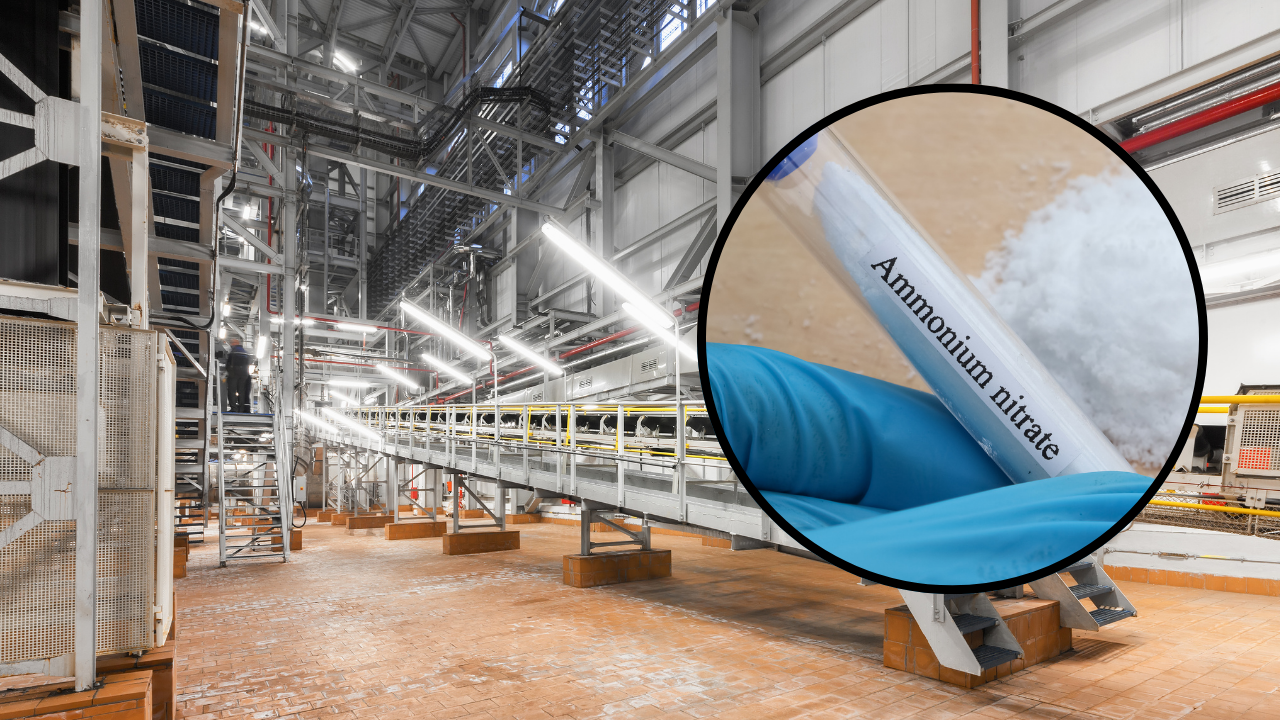Opening up chemical industry based on Ammonium Nitrate

Know about Ammonium Nitrate
Ammonium nitrate, NH₄NO₃, is one of the most important chemical compounds in any respect, mainly used in fertilisers and explosives. It is of prime importance in agriculture and in industrial explosives used in mining and construction. Its production involves the neutralisation of ammonia by nitric acid under very controlled safety and regulatory measures.
Chemical Properties of Ammonium Nitrate are-
-
Formula: NH₄NO₃
-
Density: Approximately 1.725 g/cm³
-
Melting Point: About 169°C (336°F)
-
Appearance: White crystalline solid
-
Solubility: Highly soluble in water
Is Ammonium Nitrate a good option ?
Opening a chemical industry focus on Ammonium Nitrate can be a good option but it comes with a range of considerations that need to be carefully evaluated. Here are some key points to remember -
ADVANTAGES -
-
Ammonium nitrate is used as a fertiliser and contains nitrogen necessary for plant growth.
-
It is applied in the creation of industrial explosives, notably in mining and construction.
-
The process of producing ammonium nitrate has been developed over the years and is based on simple chemical reactions.
-
A stable and established market in several industries can give a constant flow of revenue for ammonium nitrate.
-
Greater purchases of local services and infrastructure could further the growth in the local economy and the development of the region as a whole.
-
State-of-the-art technology can lend a much-needed boost to the efficiency of production, reducing the associated cost and providing better products.
-
R&D work may result in new formulations and applications for ammonium nitrate, increasing the product's potential utility and market availability.
-
A manufacturing plant could be set up for the export of ammonium nitrate to international markets, diversifying sources of income.
-
Keeping pace with global market trends and adjusting production strategies can lead to exploiting better ways of profiting from the emerging opportunities in different regions.
-
The investments in green technologies and practices can improve environmental performance and the carbon footprint of the industry.
-
The integration of raw material production to support ammonium nitrate plants allows cost efficiencies to be achieved with better control over the supply chain.
-
Stable demand for fertilisers and industrial explosives provides a sound platform with less volatility across markets.
-
Diversification of risk: By serving various sectors and markets, it reduces possible risks resulting from a downward cycle in any sector.
Read Related Books : Chemical Technology (Organic, Inorganic, Industrial), Fine Chemicals
CHALLENGES AND CONSIDERATIONS-
-
Ammonium nitrate is, however, an oxidising agent. Under certain conditions, it can be highly explosive. Strict safety measures should be undertaken to avoid accidents.
-
It should be safely kept, handled, and stored to avoid contamination and accidental ignition.
-
Due to the probable usage in explosives, the manufacture, storage, transport, and selling of ammonium nitrate are put under strict regulations.
-
Acquiring the licence and permits one needs to operate is usually complicated and usually time-consuming.
-
Overapplication of ammonium nitrate fertilisers may lead to environmental water-pollution and eutrophication issues.
-
Attention paid to by-products and emissions arising from a production process is highly necessary to reduce the environmental impact.
-
The market for ammonium nitrate is competitive, with big players dominating the market.
-
This means that the prices of raw materials like ammonia and nitric acid and those of the final product could be very volatile, thus affecting profitability.
-
Setting up a chemical plant for the production of ammonium nitrate requires huge capital investment in infrastructure, equipment, and associated safety measures.
-
Modern production plants, in most cases, require the infusion of high technology and specialised knowledge if they are to be operated efficiently and safely.
Read Project Report : Chemicals (Organic, Inorganic, Industrial) Projects
FUTURE PROSPECTS -
-
Either economic growth or infrastructure development in different regions can increase the demand for ammonium nitrate.
-
Better developed capabilities in technology, operational efficiency, and market intelligence provide a business with a competitive edge.
-
Adopting digital technologies in supply chain management provides real-time insights and brings improvement in decision-making.
-
Changes in consumer and market preferences can affect the demand for ammonium nitrate products.
-
In general, the working concepts and principles of green chemistry can improve environmental performance and help achieve global goals for sustainability.
-
The growth of waste management and recycling technologies in this sector can help decrease environmental impact and increase the sustainability profile of the industry.
-
As global demand for minerals and resources increases, so does the demand for ammonium nitrate-based explosives in mining.
| Best Locations in India to open Ammonium Nitrate chemical industry |
-
Dahej, Hizara, Vadodara of Gujarat
-
Mumbai, Pune, Raigad, Nagpur of Maharashtra
-
Chennai, Cuddalore, Tuticorin of Tamil Nadu
-
Visakhapatnam, Krishnapatnam of Andhra Pradesh
-
Paradeep, Angul of Odisha
-
Bangalore and Mangalore of Karnataka
-
Alwar, Bhiwadi of Rajasthan
CONCLUSION
Setting up an ammonium nitrate chemical industry is a prospective idea with huge potentiality in both agricultural and industrial markets. Provided the choice of a strategic location like Gujarat, Maharashtra, Tamil Nadu, Andhra Pradesh, Odisha, Karnataka, or Rajasthan, firms can get local advantages in terms of strong industrial infrastructure, proximity to raw materials, and excellent logistics networks. Critical steps include extensive market research, detailed planning, strict adherence to safety and regulatory requirements, and investments in the latest technologies and equipment. Besides, a focus on environmental management and sustainability practices will go a long way in fending off associated risks and ensuring community acceptance and regulatory approval.
For any Inquiry on Chemical Industry : Visit NPCS
See More Links:
YouTube Channel
Startup Consulting Services
Start a Business in Middle East Countries
Most Demandable Business Ideas for Startups
Business Ideas with Low, Medium & High Investment
|